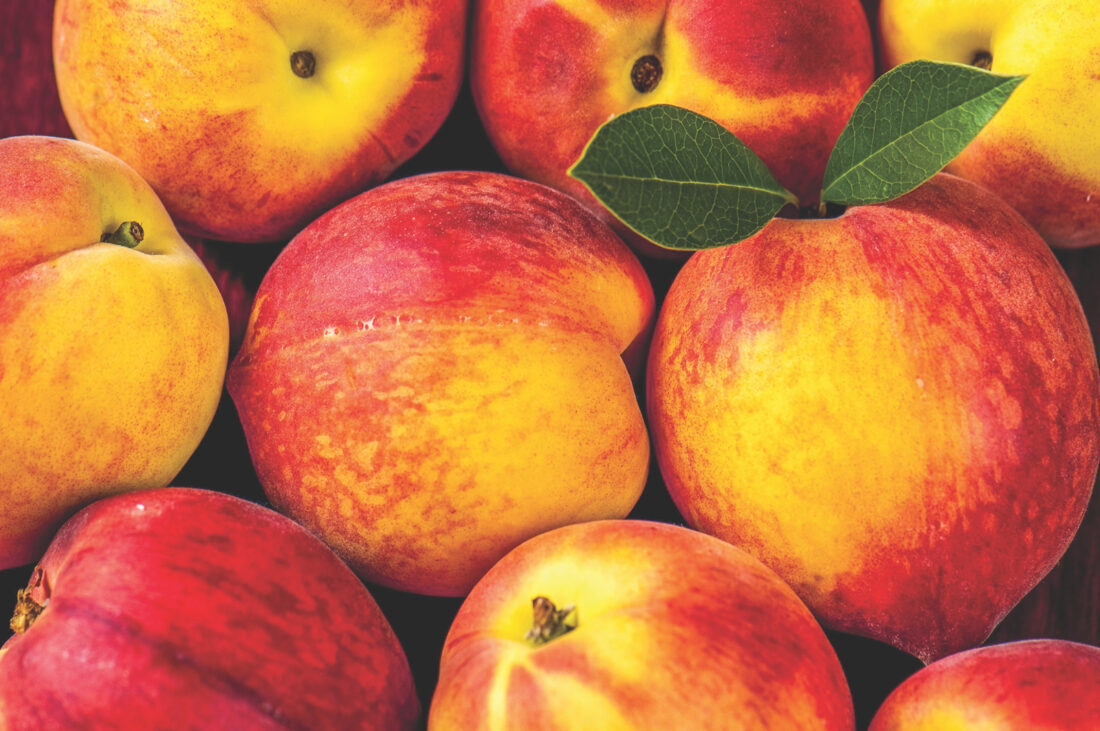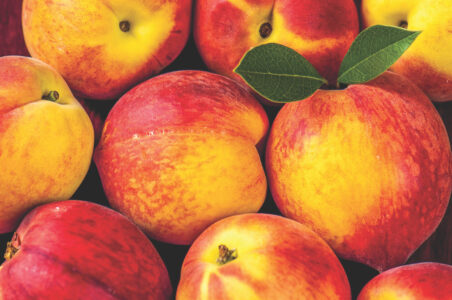Peach perfect
- Photo Illustration

Photo Illustration
By J.J. Barrett
Hello Mid-Ohio Valley Farmers and Gardeners! Peach season is in full swing as many different types and varieties are available at the grocery store, farmers market and directly from the farm. Many of you will take these treasures home to eat fresh, as well as canning, freezing and processing into jams and pie filling.
Peaches are typically classified as freestone (flesh readily separates from the pit) or clingstone (flesh clings tightly to the pit). Freestone varieties are considered more popular for canning. Good varieties for canning include “Veteran,” “Elberta,” “Rochester,” “Hale,” “Alamar,” “Redglobe,” “Redhaven” and “Sun Crest.”
Select peaches that are fairly firm. Avoid hard peaches which have a distinct green color. These are immature and probably will not ripen satisfactorily. They also will be hard to peel and the pits will cling even when ripe. Avoid overripe peaches and those with large bruises or signs of decay. A bushel of peaches weighs about 48 pounds and yields about 18-24 quarts of fruit. It takes about two to three pounds of peaches to fill a quart jar.
Everyone loves peaches for their amazing taste, but they are also a nutritional powerhouse. One medium peach only has 60 calories and more than 20 different macro and micronutrients. This includes fiber, potassium, zinc, and vitamins A, C, and E. Peaches are most often used in sweet desserts but can hold the title role in a variety of recipes.
Fun Ag Fact: Although Georgia is known as the “Peach State,” actually California dominates the peach market in the U.S. growing about 70% of the sweet fruit. South Carolina is second and Georgia comes in third. West Virginia ranks 11th in peach production.
Growing peaches (Prunus persica) can be both fun and rewarding. Peaches may be canned, frozen, dried, pickled and processed into jams and preserves. Many backyard gardeners in the Mid-Ohio Valley have peach trees or want to plant them.
However, it can be challenging to enjoy a harvest every year. Peaches and other stone fruits bloom early in the spring, which is notorious for temperature fluctuation. A few warm days might be followed by a cold night with frost, which is the biggest enemy of stone fruits. The delicate flowers are easily frozen, and a whole season’s worth of fruit might be lost in a single cold night.
Choosing the right place for a fruit tree to grow is very important for overall success. Peach trees require well-drained soil and ample sunlight. Poorly drained soils can lead to stunted tree growth. Peach trees need to have sun from 8 to 10 hours per day to assure sufficient photosynthesis and promote tree health and vigor.
Keep in mind quality is important when buying peach trees. Many times bargain plants are not healthy or may be a variety not adapted to our area. Buy only recommended varieties from a reliable nursery. Adams County Nursery in Pennsylvania or Stark Brothers are good choices. Work with your local nursery to order trees well in advance to get the varieties you want.
Select healthy 1-year-old trees, about 3-4 feet tall and with a good root system. A small tree with a good root system is more desirable than a large tree with a poor root system. Do not purchase trees that appear stunted, poorly grown, or with disease or insect damage.
Check the trees closely to make sure that you are getting the variety and rootstock that you want. For backyard gardeners, I recommend dwarf or semi-dwarf trees. Being smaller, true dwarf varieties will be easier to prune and harvest. However, they will need some support for their root system.
Peach trees should be purchased from a reputable nursery to ensure they are true to variety and free of disease. Most nurseries also provide a guarantee of survivability (many replace one time). Check for this guarantee before ordering trees.
To plant a peach tree, dig a hole twice as wide as the width of the rootball and deep enough so that the tree is at the same depth that it was in the nursery. Gently spread the roots in the hole and cover them with soil. Firm the soil around the stem and remember to water the soil thoroughly after finishing.
One of the most important aspects of growing peach trees is pruning. This task is performed primarily in late February or early March during the dormant season. Unlike apple or pear trees, peach trees are trained to the open center system, designed to give the tree an open, vase-like shape to optimize light distribution within the tree.
The first three years of growth should be devoted to training the peach tree to a shape that will allow it to bear a full crop. Pruning keeps the tree at a desirable height, removes dead, damaged, and diseased wood, and decreases the incidence of certain diseases by allowing the foliage and fruit to dry more quickly. Pruning also keeps the tree open to light, which helps maintain fruit production close to the trunk.
It is a good idea to thin mature peach trees each year. Thinning is removing some of the flowers or young fruit early in the season to decrease the total number of fruit produced. This increases the size and quality of peaches that do mature.
Thinning helps reduce the problem of branches bending or breaking due to heavy fruit loads in mature trees. In addition, it also helps limit disease problems by creating more space between fruits. A properly thinned tree should have peaches growing about 6 inches apart on the stem.
Today there are more than 200 commercial peach tree varieties available to farmers and backyard gardeners. “Elberta” was one the first varieties available in the U.S., introduced in the late 1800’s. Bred for earlier ripening and improved commercial traits, “July Elberta” (developed from the classic Elberta peach by Luther Burbank), is one of the most popular varieties currently in production.
Peach flowers are self-fruitful, so it is not necessary to plant more than one peach variety in the backyard. “Reliance,” “Biscoe,” “Challenger,” “Contender,” “Earliglow,” “Encore,” “Flamin Fury,” “Harmony,” “Madison,” “Red Rose,” “Redhaven” and “Saturn” are just a few of the varieties recommended for West Virginia.
Brown rot is one of the most common and serious diseases affecting peaches, caused by the fungus Monilinia fructicola. It can also infect flower blossoms and shoots. This disease starts with small, round brown spots which eventually expand to rot the entire fruit.
Interested in more information about growing peach trees? Contact me at the Wood County WVU Extension Office 304-424-1960 or jj.barrett@mail.wvu.edu with questions. Good Luck and until next time, Happy Gardening!

